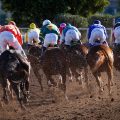Horse racing is a thrilling sport that combines the athleticism of horses with the strategy of jockeys and trainers. Understanding the rules of horse racing can enhance your enjoyment of the sport, whether you’re a spectator, a bettor, or involved in the industry. This comprehensive guide covers all the essential rules of horse racing, from the basics of the races to specific regulations.
The Basics of Horse Racing
The Track: Horse races are held on oval tracks, which can be made of dirt, turf, or synthetic materials. The length of the track and the type of surface vary depending on the race.
The Horses: Thoroughbreds are the most common breed used in horse racing, known for their speed and agility. Other breeds, such as Standardbreds and Quarter Horses, are used in specific types of racing.
The Jockeys: Jockeys are the riders who guide the horses during the race. They wear colored silks that represent the horse’s owner or trainer.
Types of Races
Flat Racing
- Distance: Races range from 5 furlongs (about 1 km) to 2 miles (about 3.2 km).
- Starting Gates: Horses start from stalls or gates to ensure a fair start.
- Finish: The winner is the first horse to cross the finish line.
Jump Racing (National Hunt Racing)
- Hurdle Races: Horses jump over hurdles, which are at least 3.5 feet high.
- Steeplechase Races: Horses navigate a course with various obstacles, including fences and ditches.
- Distance: Races are generally longer than flat races, ranging from 2 to 4.5 miles.
Harness Racing
- Trotting and Pacing: Horses race at a specific gait (trot or pace) while pulling a two-wheeled cart called a sulky.
- Starting Gate: A mobile starting gate ensures a rolling start.
Betting and Wagering
Types of Bets: Common bets include win (horse finishes first), place (horse finishes first or second), and show (horse finishes first, second, or third). There are also exotic bets like exactas, trifectas, and superfectas, which involve predicting the exact order of finish for multiple horses.
Pari-Mutuel Betting: Most horse racing bets are pari-mutuel, meaning all bets of a certain type are pooled, and the payout is determined by the total amount wagered and the number of winning bets.
Rules and Regulations
Age and Eligibility: Horses must meet age and qualification requirements to race. For example, the Kentucky Derby is limited to 3-year-old Thoroughbreds.
Weight: Horses carry weights based on the conditions of the race. This can include the jockey’s weight and additional weights to equalize the competition.
Safety and Welfare: Rules are in place to ensure the safety and welfare of the horses and jockeys. This includes regulations on equipment, track conditions, and veterinary care.
Drug Testing: Horses are subject to drug testing to detect prohibited substances and ensure fair competition.
Major Horse Racing Events
- Triple Crown: The Kentucky Derby, Preakness Stakes, and Belmont Stakes are the three prestigious races that make up the Triple Crown for Thoroughbreds in the United States.
- The Grand National: A famous steeplechase held annually in the United Kingdom.
- The Breeders’ Cup: An annual series of Grade I Thoroughbred races.
Governing Bodies
Horse racing is regulated by various national and international organizations, including:
- The Jockey Club: Governs Thoroughbred racing in the United States.
- British Horseracing Authority (BHA): Governs horse racing in Great Britain.
- Fédération Internationale des Autorités Hippiques (FIAH): The international federation for horse racing authorities.
Understanding these rules is crucial for fully appreciating and enjoying horse racing. Whether you’re watching a local race or a major event like the Kentucky Derby, keeping these guidelines in mind will help you understand the complexities and nuances of this exciting sport.




